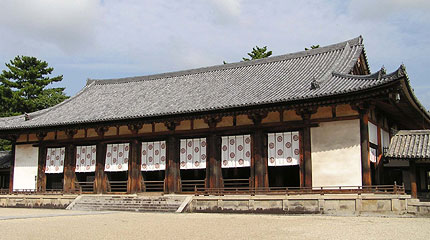|
|
| @ |
| irimoya-zukuri@üꮢ |
 |
 |
 |
 |
| KEY WORD :@architecture
/ general terms |
 |
| @ |
A
hip-and-gable roof construction, or a building with this roof construction. A
gable type roof has a ridge and gable pediments on the upper part and a hipped
roof on the four sides on the lower part. This roof style was introduced from
China at the same time as Buddhism in the mid 6c. In Japanese temple buildings
the gable part of the roof usually covers the central core *moya ê®, while the hipped part covers the surrounding aisle *hisashi ù. This style of roof is used on many types of traditional buildings including
castles and folk dwellings. On folk-dwellings, it is often called moya-zukuri ꮢ. Its popularity increased during the Kamakura period and continued
to be used more and more often for important buildings in the following centuries.
Examples; Houryuuji *Daikoudou @²åu° (990) tile roof in Nara, Toyomitsu Jinja L_Ð (1323),
four-legged gate Shikyakumon lrå, finely layered shingles and cypress bark roof in Shiga prefecture.
|
| @ |

|
@ |
 |
 |
| REFERENCES: |
| *noyane 쮪, *shikorobuki èC |
 |
 |
 |
| EXTERNAL LINKS: |
| @@ |
 |
 |
 |
| NOTES: |
|
@ |
 |
 |
 |
(C)2001 Japanese Architecture and Art Net Users System.@No reproduction
or republication without written permission.
fÚÌeLXgEÊ^ECXgÈÇASÄÌRec̳f¡»E]ÚðֶܷB |
| @ |



